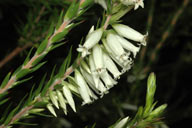In Flower This Week
A news sheet prepared by a Gardens' volunteer.
Numbers before each plant refer to temporary IFTW labels in the gardens.
Numbers in square brackets [ ] refer to garden bed Sections. Plants in flower are in bold type.
View past issues of 'In Flower This Week'.
13 May 2015
Epacris calvertiana var. calvertiana click for larger image |
Today we will walk from the Visitor Information Centre (VIC) behind the café and along the bitumen road at the top of the Rock Garden.
- Bear left up the hill behind the café to see on your right Grevillea bipinnatifida ‘Jingle Bells’ [Section 124], a standard grevillea with deeply-divided stiff, prickly foliage and many trusses of pink and orange flowers.
- Further along on the right is Banksia spinulosa var. spinulosa [Section 109], or Hairpin Banksia, which is found in open forests and woodlands of the coasts and mountains of New South Wales and Queensland.
- On your left is Notelaea lloydii [Section 114]. This small light bush has linear leathery leaves with small clusters of yellow bell flowers. Lloyd's Olive is only known from eight sites at five locations within south-east Queensland and is listed as vulnerable.
- On your left are several plants of Plectranthus alloplectus [Section 114], with coarse ovate foliage and long sprays of mauve flowers. This plant grows naturally in coastal New South Wales and Queensland.
- On your right is Epacris calvertiana var. calvertiana [Section 17], which occurs in coastal regions of New South Wales, with cream bell flowers on dark green foliage.
- Turn right along the road to see on your right Chamelaucium ‘Cascade Brook’ [Section 17], or Geraldton Wax. Endemic to Western Australia, it is an open airy shrub with masses of purplish-pink five-petalled flowers with darker maroon centres.
- Chamelaucium uncinatum ‘Murfit Rose’ [Section 17] on your right is another Geraldton Wax cultivar, with fine foliage and paler pink flowers that darken as they age. This cultivar is a selection developed from a seedling of C. uncinatum found in a cleared paddock near Geraldton, Western Australia.
- Further on your right is Grevillea lanigera [Section 15h], with grey-green foliage and pink and cream flowers on a low shrub. The species occurs in Victoria and New South Wales. Also known as Woolly Grevillea it is very long-flowering and useful in the garden.
- On your right a little down the path under the “Genus Hakea” sign is Hakea drupacea [Section 20], commonly known as Sweet Hakea. It is an open tree or shrub with white starburst flowers. It is native to south west Western Australia.
- Further along the road and also on your right is another specimen of Hakea drupacea [Section 20], with large white sweet-smelling balls of flowers with pink stamens. Here it has formed a small sprawling tree with fine green linear foliage.
- Hakea varia [Section 20], on your right, has hard prickly variable foliage which droops and small white starburst flowers. It grows naturally in south-western Western Australia.
- Also on your right is Grevillea triloba [Section 22], a spreading shrub with grey-green foliage and white starburst flowers. It grows near Geraldton in Western Australia.
- Correa reflexa var. speciosa [Section 112], on your right occurs in coastal New South Wales and Victoria. It is a low plant with rugose oblong foliage and large pink bell flowers with green tips.
- Turn right down the Main Path to see on your left Correa ‘Marian’s Marvel’ [Section 112], with flared pale pink bell flowers with long greenish tips. This beautiful correa is a cross between C. reflexa and C. backhouseana. It arose in the garden of Marion Beek of Naracoorte, South Australia.
- Grevillea centristigma [Section 26], also on your left, is a small bush with soft lush foliage fringed with with white hairs. Pendent hard yellow/orange flowers open from greenish buds. It is endemic to the south west region of Western Australia.
You can now return to the VIC by following the Main Path, enjoying more of the Gardens along the way.
Rosalind Walcott
![Director of National Parks [logo]](../../../../images/dnp_90px.gif)







